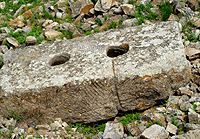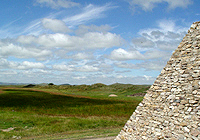Located some 20 kilometers northeast of the government of Zhenglan Banner, the Xilingol League in Inner Mongolia, Shangdu city of the Yuan Dynasty (1271-1368) was destroyed by the rebel army and is now overgrown with grassland that looks no different from pasture in other places. Under the guidance of Wei Jian, vice head of the Culture Relics and Archeology Research Institute, the streets and buildings of the ancient city can be roughly made out.
Wei Jian said, the fengshui (geomantic omen) of the area is good -- located on the Jinlianchuan Plain (Yellow Lilies Plain), south of the upper reaches of the Luanhe River, of which it lies on the north bank. When the summer comes golden lilies are in full bloom and the grass is a moving golden sea.
According to Wei, Shangdu city is square, consisting of the palace city, imperial city and outer city. The outer city is a square of 2,200 meter sides. The city walls were built from stone and earth. The imperial city lies to the southeast corner of the outer city, which used to be occupied temporarily by imperial officials accompanying the emperor during summers there. It's all built of stone. The palace city is a rectangle with two sides, 605 meters and 542 meters; a center of which used to be where the emperor and his wives lived. It was built with bricks.
 To the south of the city is the city gate, a double-security gate which was given the name, wengcheng (earthen jar city) owing to its fortified nature and shape. Because this city wall forms a square, with all four sides protected by sentry soldiers on the battlements, and with two gates at the north and south wall, enemies were easily defeated when they broke in. Now the wengcheng is under excavation and revivification.
To the south of the city is the city gate, a double-security gate which was given the name, wengcheng (earthen jar city) owing to its fortified nature and shape. Because this city wall forms a square, with all four sides protected by sentry soldiers on the battlements, and with two gates at the north and south wall, enemies were easily defeated when they broke in. Now the wengcheng is under excavation and revivification.
The construction history of Shangdu city was closely connected with the history of the Yuan Dynasty and Emperor Kublai Khan. Before Kublai Khan became the first Emperor of the Yuan Dynasty, he was the Khan of Kaiping prefecture, and decided to build the Kaiping prefecture government office, which was then to become Shangdu city of Yuan Dynasty.
It was designed by Liu Bingzhong, Kublai Khan's adviser of Han ethnic group. After four years' construction, it was completed in 1256. The design of the capital embodied the layout of a traditional Han city and at the same time took into consideration the habit of Mongolians' nomadic life style.
In 1260, Kublai Khan succeeded to the throne, calling it Kaipingfu (Kaiping prefecture government office). In 1271, he named his reigning dynasty as Yuan and established the capital of Yuan Dynasty, which was named Dadu (central capital) then, to the present Beijing. The Kaipingfu was therefore renamed, Shangdu, which means both earlier capital and northern capital in Chinese, and had once been the summer resort of Kublai Khan. The site of Shangdu is now under state protection.
Wei said, "According to construction features, we can draw a conclusion that the palace city and imperial city were built first and that was what appeared in the ancient history books and poems as the 'stone city'. When Kublai Khan became the first emperor of the Yuan Dynasty and Shangdu city became the capital, the outer city was added to the north and the west of imperial city. This place then became a fair and trade area, named xiguan (the west pass) -- the most important place for normal citizens there.
Marco Polo was received by Kublai Khan in Shangdu city. He described the city in his book: "A city named Shangdu, which was built by the Khan who is now in power. There are a lot of beautiful palaces built out of stone in the city. All the houses are covered with gold and decorated with the pictures of birds, animals and flowers. These buildings and patterns are so beautiful that they are pleasing to the eye." From what Marco Polo described, we can imagine how prosperous the city was at that time.

The groundsill of citizen's houses can still be pointed out clearly. Every house is over 100 square meters. This was once the most prosperous place in the country. Today in the Mongolian language, Shangdu city of the Yuan Dynasty is called "108 temples" -- we can see why.
In 1358 the red scarf rebellion army set fire to the city and it was destroyed. Archeologists found some stone pillars also melted in the blaze.
Fortunately, some relics survived: a 65 centimeters high and 250 kilograms weight iron kettle, which is rare in China; the Tiegan trench designed by Guo Shoujing, one of the most famous scientists in Yuan Dynasty, which was the only ancient irrigation work for pasture land; a palace, civilian houses, tombs and sacrificial relic sites; four white marble human sculptures excavated from the royal sacrifice site, 35 kilometers northwest of Shangdu city and so on.
The Mongolians had grasped the most advanced military, weather, economy, and geology science of the world in the 1200s. Shangdu City was zero degrees in a south-north direction. The man-made water draining system was also rare and was partly due to the enlightened emperors of the Yuan Dynasty -- they were Mongolians but broadly heard the opinions of other ethnic groups. Kublai Khan had many Han advisors, and the seven Arab People's tombs in the southeast of Shangdu City imply that the emperors employed Arab advisors.
Now Shangdu city is under excavation. The leading official of the Zhenglan Banner said that the people of Inner Mongolia look on Shangdu city as the buried jewel of their crown. Because their ancestors made their contribution in unifying China, they deserve respect for this. Although Shangdu city only left a few groundsills, Mongolians think it's sacred and protected, because they believe their ancestors' souls are buried there. It is said that someone once saw the grand palaces, high walls, many banners, war horses, and prosperous crowds on the groundsills. Local people call the mirage scenery, xiancheng (city apparition).
(China.org.cn by staff reporter Chen Lin, October 13, 2003)

